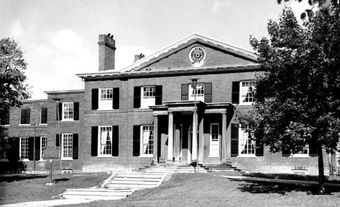In the early morning hours of Monday, 4 September 1972, three armed individuals stole 18 paintings and 39 figurines and pieces of jewelry from the Montreal Museum of Fine Arts. Only two works — a painting and a pendant — have since been recovered, both of which were returned to police as part of unsuccessful efforts to reclaim the entire lot. Valued at $2 million in 1972, the artworks were estimated to be worth $20 million in 1992, although a rare Rembrandt landscape was estimated to be worth $20 million alone in 2017. The heist is the most valuable theft in Canadian history and remains unsolved.

The Robbery
Shortly after 12:00 a.m. on Monday, 4 September 1972, an individual wearing picks on their boots climbed up a tree on the west side of the Montreal Museum of Fine Arts’ Michal and Renata Hornstein Pavilion on Sherbrooke Street West. (At the time, this was the museum’s only pavilion.) He lowered a ladder, which was on the roof for repairs, down to two accomplices who were waiting on the building’s west side. It is believed that the trio were men; two of them spoke French while the third spoke English.
The trio entered the museum through a skylight. Though the skylight was usually equipped with an alarm, it had been deactivated due to the repairs on the museum’s roof. The three wore ski masks and carried at least one sawed-off shotgun and a revolver. They slid down a nylon rope to enter the museum’s second floor. Around 1:30 a.m., they came across one of the guards and fired a shotgun blast to demand his compliance. The gunshot alerted the other two guards on duty that night. The three guards were tied up and brought to a lecture hall. While one of the men watched the guards, the other two went about collecting paintings, figurines and other objects.
The thieves had apparently planned to exit the museum through the same skylight they had entered, as they spent some time putting together an elaborate pulley system to hoist the artworks up to the roof. They ultimately gave up on this and decided to bring the artworks and other items to the museum’s loading dock and escape in the museum’s panel van. As one of the men exited the museum through a side entrance, he triggered the alarm. The trio took whatever they could get their hands on before likely fleeing on foot with 18 paintings and 39 smaller pieces, mainly jewelry and figurines. Among these were two 17th century Spanish pendants and an 18th-century gold watch that had been owned by Montreal’s first mayor, Jacques Viger.

Stolen Paintings
- Landscape with Vehicles and Cattle. This painting, which was subsequently recovered, had been attributed to Jan Brueghel the Elder but was later determined to be the work of his students.
- Landscape with Buildings and Wagon by Jan Brueghel the Elder.
- La rêveuse á la fontaine (The Dreamer at the Fountain) by Jean-Baptiste-Camille Corot.
- Jeune femme accoudée sur le bras gauche (Young Girl Leaning on Her Left Arm) by Jean-Baptiste-Camille Corot.
- Landscape with Rocks and Stream by Gustave Courbet.
- Head by Honoré Daumier.
- Lioness and Lion in a Cave by Eugène Delacroix.
- The Sorceress by Narcisse Virgilio Díaz de la Peña.
- Portrait of Brigadier General Sir Thomas Fletcher by Thomas Gainsborough.
- Vanitas Still life with Books, a Globe, a Skull, a Violin and a Fan, by Jan Davidszoon de Heem.
- Still Life with a Fish by Jan Davidszoon de Heem.
- La baratteuse (Young Woman Churning) by Jean-François Millet.
- Portrait of Madame Millet by Jean-François Millet.
- Portrait of a Man, Possibly a Self-portrait by Giovanni Battista Piazzetta.
- Landscape with Cottages by Rembrandt van Rijn.
- Head of a Young Man by Peter Paul Rubens.
- Portrait of a Lady by François-André Vincent.
- Portrait of a Man by François-André Vincent.
Investigators noted that most of the stolen paintings were small enough to carry easily, and that other, larger paintings had been removed from the walls and stacked. It was hypothesized that the thieves were limited by what they could carry, so they prioritized smaller pieces and stuffed jewelry in their pockets after they abandoned their plan to leave in the museum van. In their haste to flee, they had left behind paintings by El Greco, Picasso, Tintoretto, and Rembrandt.

Initial Investigation
The theft was one of several major news stories to occur over the Labour Day weekend of 1972. At the Montreal Forum on 2 September, the Canadian hockey team lost the first game of the 1972 Summit Series against the Soviet Union. By the morning of 5 September, most of the world’s attention was focused on the hostage crisis at the Munich Olympics. As a result, the art heist did not receive the attention it otherwise might have earned.
The security guards managed to free themselves roughly an hour after the thieves fled, at which point they contacted the highest-ranking available member of the museum’s staff, who told them to contact the police. A press conference the following Monday was well-attended. News of the robbery and the names of the stolen works were printed in newspapers across North America. Investigators contacted Interpol as well as the Art Dealers Association and the International Art Registry. The Montreal police also quickly issued a notice to border checkpoints, alerting customs officials to be on the lookout for the stolen works.
Early in the investigation, police focused on the possibility that the theft was committed by art students. They surveilled five students for just over two weeks before abandoning this lead. One investigator later said that they were looking for at least one suspect — a man between the age of 35 and 40. The only other details concerning the suspects was that they were all men, that two of them were approximately 5-foot-6 and had long hair, and that two of the three spoke French while the third spoke English. Guards only saw two of the three suspects.
Despite the hypothesis that the culprits fled on foot, carrying the paintings and other items, the police never recovered the shotgun or revolver they were said to have carried. That the suspects knew to use the one skylight with a deactivated alarm led investigators to consider the possibility of an inside job. However, after interviewing museum staff they determined this to be inconclusive.
Failed Ransom and Recovery Attempts
Within a few days of the crime, someone claiming responsibility contacted the museum and instructed them to go to a payphone near McGill University. A man with a “European-sounding voice” told one of the museum staffers to pick up a discarded cigarette package on the ground. Inside was a pendant — one of the stolen items. The presumed thieves continued to communicate with the museum by phone and mail.
A brown envelope labelled “Port of Montreal” was received by the museum in late October 1972. It contained photos of the paintings. A ransom of $500,000 was requested for the return of the paintings and objects. This was then lowered to $250,000. In the correspondence with the presumed thieves, the director of the museum suggested returning one of the paintings as a sign of good faith. The painting selected, Landscape with Vehicles and Cattle, was attributed to Jan Brueghel the Elder. However, the painting was later determined to be a misattribution (a copy of the original). A subsequent effort to exchange cash for another painting using an undercover officer fell apart, with the presumed thieves claiming that it had been a police set-up. Communication ceased shortly thereafter.
In the early summer of 1973, another museum official was contacted by someone who claimed to have information about the stolen paintings. An insurance adjuster was sent on a wild goose chase to eleven different phone booths located across Montreal. Following instructions, the adjuster left $10,000 in cash at the foot of a sign in a vacant lot on St. Martin Boulevard in Laval. The adjuster was supposed to receive one final call indicating the location of the painting but it never came. A call later the following day indicated the paintings were at a motel in Laval, but nothing was found there.
No ransom or other attempt to return the paintings has been made since the summer of 1973.

Subsequent Developments
Alain Lacoursière, a Montreal police detective, began working on the cold case in the 1990s. It was largely a part-time effort for the detective, who had become known as “the Colombo of art” for his successful efforts investigating other art thefts in Quebec. He was not able to solve the case and has gone on record with his frustration over the sloppy manner with which the investigation was initially handled.
However, Lacoursière did develop an interest in an individual he called “Smith” — a student at the École des beaux-arts de Montréal at the time of the theft (though not one of the five suspects initially surveilled by police). Smith knew details of the crime that were not made public and seemed to come into a considerable amount of money shortly after graduating from school. Lacoursière has said that he believes Smith may have been one of the three men involved but not the mastermind. Smith has denied any involvement.
Another development was the realization that another major theft had occurred just days before the museum heist. It was also said to have involved three armed men, two francophones and one anglophone, who used ropes to scale the side of a steep cliff to steal artworks from the summer home of Agnes Meldrum, who ran a successful trucking and storage business in Montreal. The police noted the similarities between the crimes but considered them a coincidence.
Aftermath
The theft brought the stolen artworks to greater international attention but also led to greater scrutiny. It was later discovered that several paintings — including the one that was returned to the museum as part of ransom negotiations — had been misattributed or had other details that were inconsistent with the careers and styles of the masters they allegedly represented. Adding insult to injury, the painting that was later acquired by the museum using the nearly $2 million insurance settlement — Peter Paul Rubens’ The Leopards — was also determined to likely have been misattributed. It has not been exhibited since.

 Share on Facebook
Share on Facebook Share on X
Share on X Share by Email
Share by Email Share on Google Classroom
Share on Google Classroom



